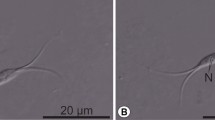Abstract
Trypanorhynch cestodes are common parasites of marine fish with complicated life cycles which have been suggested as model taxa to study the evolution of marine helminth parasites and their life cycles. Among the Trypanorhyncha, the genus Grillotia includes 18 valid species, of which only four have been found in Mediterranean fish hosts. Morphological, histopathological, and molecular data are presented on a massive Grillotia plerocercus infection in an anglerfish (Lophius piscatorius) from the Tyrrhenian Sea. BLAST analysis of the 28S rDNA sequences revealed 99% similarity between specimens here found and a G. (Bathygrillotia) rowei sequence available in GenBank with a total of six nucleotide site differences. A morphological study suggested that the Grillotia sp. here reported did not match important characters to those previously reported from the Mediterranean Sea. Taking in account these differences, we prefer to place these specimens within Grillotia sensu lato until more material is available for study including sequences from adult specimens of Grillotia spp. from the Mediterranean Sea.



Similar content being viewed by others
References
Beveridge I, Campbell RA (2001) Grillotia australis n. sp. and G. pristiophori n. sp. (Cestoda: Trypanorhyncha) from Australian elasmobranch and teleost fishes. Syst Parasitol 49(2):113–126
Beveridge I, Campbell RA (2007) Revision of the Grillotia erinaceus (van Beneden, 1858) species complex (Cestoda: Trypanorhyncha), with the description of G. brayi n.sp. Syst Parasitol 68:1–31
Beveridge I, Campbell RA (2010) Validation of Christianella Guiart, 1931 (Cestoda: Trypanorhyncha) and its taxonomic relationship with Grillotia Guiart, 1927. Syst Parasitol 76(2):111–129
Beveridge I, Campbell RA (2012) Bathygrillotia n. g. (Cestoda: Trypanorhyncha), with redescriptions of B. rowei (Campbell, 1977) n. comb. and B. kovalevae (Palm, 1995) n. comb. Syst Parasitol 82(3):249–259
Beveridge I, Campbell RA (2013) A new species of Grillotia Guiart, 1927 (Cestoda:Trypanorhyncha) with redescriptions of congeners and new synonyms. Syst Parasitol 85(2):99–116
Bryan DR, Jacobson KC, Buchanan JC (2012) Recent increase in Nybelinia surmenicola prevalence and intensity in Pacific hake (Merluccius productus) off the United States west coast. J Parasitol 98(1):85–92
Campbell RA, Beveridge I (1994) Order Trypanorhyncha Diesing, 1863. In: Khalil LF, Jones A, Bray RA (eds) Keys to the cestode parasites of vertebrates. Commonwealth Agricultural Bureaux International, Wallingford, pp 51–148
Dallarés S (2016) Twenty thousand parasites under the sea: a multidisciplinary approach to parasite communities of deep-dwelling fishes from the slopes of the Balearic Sea (NW Mediterranean). PhD Thesis. Universitat Autònoma de Barcelona
Dallarés S, Moyà-Alcover CM, Padrós F, Cartes JE, Solé M, Castañeda C, Carrassón M (2016) The parasite community of Phycis blennoides (Brünnich, 1768) from the Balearic Sea in relation to diet, biochemical markers, histopathology and environmental variables. Deep-Sea Res Part I 118:84–100
Dollfus RP (1969) De quelques cestodes tétrarhynques (hétéracanthes et pécilacanthes) récoltés chez des poisons de la Méditerranée. Vie et Milieu 20:491–542
Gòmez-Morales MA, Ludovisi A, Giuffra E, Manfredi MT, Piccolo G, Pozio E (2008) Allergenic activity of Molicola horridus (Cestoda, Trypanorhyncha), a cosmopolitan fish parasite, in a mouse model. Vet Parasitol 157(3–4):314–320
Guiart J (1935) Cestodes parasites provenant des campagnes scientifiques de S. A. S. le Prince Albert I″ de Monaco (1886–1913). Résultats des campagnes scientifiques accomplies sur son yacht par Albert 1er Prince souverain du Monaco. vol. 91 pp 3–115
Hall TA (1999) BioEdit: a user-friendly biological sequence alignment editor and analysis program for Windows 95/98/NT. Nucleic Acids Symp Ser 41:95–98
Jensen K, Bullard SA (2010) Characterization of a diversity of tetraphyllidean and rhinebothriidean cestode larval types, with comments on host associations and life cycles. Int J Parasitol 40:889–910
Paggi L (2008) Cestoda. Biol Mar Mediterr 15:150–154
Palm HW (2004) The Trypanorhyncha Diesing, 1863. PKSPL-IPB Press, Bogor
Palm HW, Klimpel S (2007) Evolution of parasitic life in the ocean. Trends Parasitol 23(1):10–12
Palm HW, Waeschenbach A, Littlewood DTJ (2007) Genetic diversity in the trypanorhynch cestode Tentacularia coryphaenae Bosc, 1797: evidence for a cosmopolitan distribution and low host specificity in the teleost intermediate host. Parasitol Res 101:153–159
Palm HW, Waeschenbach A, Olson PD, Littlewood DTJ (2009) Molecular phylogeny and evolution of the Trypanorhyncha Diesing, 1863 (Platyhelminthes: Cestoda). Mol Phylogenet Evol 52:351–367
Pintner T (1930) Wenigbekanntes und Unbekanntes von Rüsselband würmern. Sitzungsberichten der Kaiserlichen Akademie der Wissenschaften in Wien, Mathematisch-Naturwissenschaftiche Klasse 139(1):445–537
Rodero M, Cuellar C (1999) Humoral immune responses induced by Gymnorhynchus gigas extracts in BALB/c mice. J Helminthol 73:239–243
Seamone S, Blaine T, Higham TE (2014) Sharks modulate their escape behavior in response to predator size, speed and orientation approach. Zool 117:377–382
Stagioni M, Montanini S, Vallisneri M (2013) Feeding habits of anglerfish, Lophius budegassa (Spinola, 1807) in the Adriatic Sea, north-eastern Mediterranean. J Appl Ichthyol 29:374–380
Thompson JD, Higgins DG, Gibson TJ (1994) Clustal W: improving the sensitivity of progressive multiple sequence alignment through sequence weighting, positions-specific gap penalties and weigh matrix choice. Nucleic Acid Res 22:4673–4680
Acknowledgments
We thank Eurofish Napoli S.r.l. for providing the anglerfish. The first draft of the manuscript was improved by the comments and advices from Mike Kinsella (Helm West Laboratory, USA). Giuseppe Di Vincenzo assembled the figures of the manuscript.
Author information
Authors and Affiliations
Corresponding author
Ethics declarations
Conflict of interest
The authors declare that they have no conflict of interest.
Additional information
Section Editor: Guillermo Salgado-Maldonado
Rights and permissions
About this article
Cite this article
Santoro, M., Uberti, B.D., Corrado, F. et al. Grillotia (Cestoda: Trypanorhyncha) plerocerci in an anglerfish (Lophius piscatorius) from the Tyrrhenian Sea. Parasitol Res 117, 3653–3658 (2018). https://doi.org/10.1007/s00436-018-6067-4
Received:
Accepted:
Published:
Issue Date:
DOI: https://doi.org/10.1007/s00436-018-6067-4




